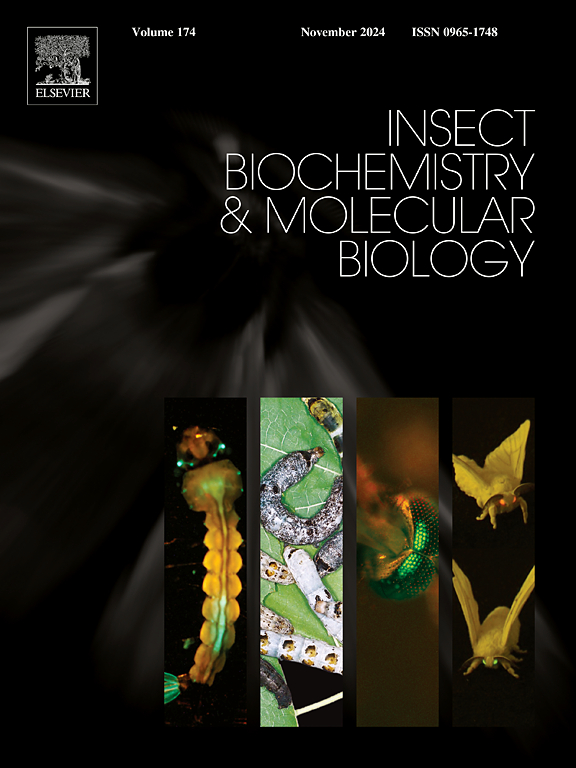Juvenile hormone regulates reproductive diapause through both canonical and noncanonical pathways in the bean bug Riptortus pedestris
IF 3.2
2区 农林科学
Q2 BIOCHEMISTRY & MOLECULAR BIOLOGY
引用次数: 0
Abstract
Diapause is an adaptive developmental arrest commonly utilized by animals to cope with seasonal changes. Central to this process are hormonal events that bridge photoperiodic cues and physiological changes. In insect reproductive diapause, the absence of juvenile hormone (JH) serves as the primary endocrine event that governs key diapause traits, including ovarian developmental arrest and lipid accumulation. Conventionally, it is believed that the effects of JH are conveyed through the receptor Methoprene-tolerant (Met) and its transcriptional factor Krüppel homolog 1 (Kr-h1). However, our study with the bean bug Riptortus pedestris reveals that JH independently regulates lipid accumulation, bypassing Met and Kr-h1 pathways. R. pedestris enters reproduction under long-day (LD) conditions, while diapause occurs under short-day (SD) conditions. Treatment of SD females with the JH mimic methoprene stimulated reproductive activities, enhancing ovary development and reducing lipid accumulation. In contrast, silencing genes essential for JH biosynthesis in LD females led to pronounced diapause characteristics, including ovarian developmental arrest and substantial lipid accumulation. Interestingly, disruptions in the JH action genes, either Met or Kr-h1, solely affected ovary development, leaving lipid accumulation unchanged, indicating an independent pathway for regulating JH in lipid accumulation. This was further confirmed by RNA interference experiments in SD females, where knockdown of Met or Kr-h1 did not alter the effects of methoprene on lipid reduction. Collectively, these results suggest that JH controls ovary development through the established Met-Kr-h1 pathway, while it modulates lipid accumulation through an alternative, yet to be identified noncanonical pathway during reproductive diapause in R. pedestris.

幼虫激素通过规范和非规范途径调节豆虫的生殖滞育。
滞育是一种适应性发育停滞,通常用于动物应对季节变化。这个过程的核心是激素事件,它将光周期线索和生理变化联系起来。在昆虫的生殖滞育过程中,幼体激素(JH)的缺乏是主要的内分泌事件,控制着关键的滞育特征,包括卵巢发育停滞和脂质积累。传统上认为,JH的作用是通过受体methoprene - tolerance (Met)及其转录因子kr ppel同源物1 (Kr-h1)传递的。然而,我们对豆虫Riptortus行人的研究表明,JH独立调节脂质积累,绕过Met和Kr-h1途径。长日(LD)条件下进入繁殖期,短日(SD)条件下进入滞育期。用JH模拟甲基戊二烯处理SD雌性刺激生殖活动,促进卵巢发育,减少脂质积累。相反,在LD雌性中,沉默JH生物合成所必需的基因导致了明显的滞育特征,包括卵巢发育停滞和大量脂质积累。有趣的是,JH作用基因(Met或Kr-h1)的破坏仅影响卵巢发育,而脂质积累不变,这表明JH在脂质积累中有一个独立的调节途径。在SD雌性中进行的RNA干扰实验进一步证实了这一点,其中Met或Kr-h1的敲低并没有改变甲基戊二烯对脂质降低的作用。综上所述,这些结果表明JH通过已建立的Met-Kr-h1途径控制卵巢发育,同时通过另一种尚未确定的非典型途径调节脂质积累。
本文章由计算机程序翻译,如有差异,请以英文原文为准。
求助全文
约1分钟内获得全文
求助全文
来源期刊
CiteScore
7.40
自引率
5.30%
发文量
105
审稿时长
40 days
期刊介绍:
This international journal publishes original contributions and mini-reviews in the fields of insect biochemistry and insect molecular biology. Main areas of interest are neurochemistry, hormone and pheromone biochemistry, enzymes and metabolism, hormone action and gene regulation, gene characterization and structure, pharmacology, immunology and cell and tissue culture. Papers on the biochemistry and molecular biology of other groups of arthropods are published if of general interest to the readership. Technique papers will be considered for publication if they significantly advance the field of insect biochemistry and molecular biology in the opinion of the Editors and Editorial Board.

 求助内容:
求助内容: 应助结果提醒方式:
应助结果提醒方式:


